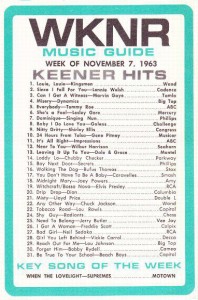 From the MCRFB NEWS archive: 1964
From the MCRFB NEWS archive: 1964
TIGHT PLAYLIST AND RATINGS RIDING WITH WLS CHICAGO, WKNR DETROIT AND WABC NEW YORK EARLY STAGE
From the Desk of Bill Gavin Billboard Contributing Editor
F O R T H E P A S T Y E A R O R S O , Top 40 station managers have been taking second looks at their playlists. More specifically, they’ve been asking themselves if the playlist should be shortened. Most of the answers have been, “Well — maybe — but let’s not change things until the experimenters have made out.” The experimenters, of course, were those few brave souls who chopped their playlist to fewer than 50 records.
 The record of the short playlist is good, but it is far from conclusive at this point. Let’s look at several cities in which the tight playlist have been tested.
The record of the short playlist is good, but it is far from conclusive at this point. Let’s look at several cities in which the tight playlist have been tested.
Cincinnati offers the most successful example of the tight list policy. For several years, WSAI has dominated this market, with a share of audience rating from 40 per cent to 60 per cent. Station policy has been to play nothing but to top 40, plus established national hits. Station WCIN, featuring mostly R&B records, has introduced much of the new material that sells in the area. Recently, station WCPO has adopted a progressive program policy which incorporates some of the strongest new material. Latest listeners surveys show WCPO’s position in that market to be improving, but not as yet a proved winner.

T H E S T O R Y O F W L S I N C H I C A G O is well known. With a tight playlist policy, introduced a couple of years ago, WLS made phenomenal rating gains and soon became the controlling influence in record sales in a wide area around Chicago. Even so, the WLS ratings are not clearly No. 1. Rating leadership is shared with WIND (and several other stations) whose policy is non-rock singles plus a few selected albums. The ABC ownership decided to give the same music policy a try in its New York station, WABC. After a false start or two, it began to produce substatial ratings gains, and is still doing well with a policy of trying to be very sure about every record added to the list. However, the amazing resurgence of WMCA has stolen most of the glory in New York. The station now heads the rating parade with a policy oriented toward being first to break the new hits.
In San Francisco last year, new ownership at KYA switched from a liberal policy (top 60 plus 30 or 40 more) to a conservative policy of top 30 plus from 10 to 20. Ratings nose-dived during the first few months, but the station has made a powerful gain recently and is generally second only to good music leader KSFO. Top 40 competition in the area has come from KEWB, a Crowell-Collier property, whose policy playing new material is considerably more liberal than KYA’s. As between KYA and KEWB, the former considerably spends more money in contests, prizes and promotions, which may have some bearing on ratings. The top advantage enjoyed by KYA is the ability to stimulate the sales of the records it plays, even though KEWB may have, and usually does, start the sales rolling in the market.

T H E M O S T R E C E N T S U C C E S S F U L convert to a tight playlist has been WKNR, in Dearborn, Michigan. Here the music policy is a top 30 plus 1. With the rapid rise and fall of hits in the Detroit market, there are about five or six new items on each week’s playlist, all but one of which had to be broken in the market by CKLW, WJBK, WXYZ or the R&B station, WJLB. Rating gains at WKNR has been phenomenal. Unofficial reports credit the station with the No. 1 position from 3 p.m. to 10 p.m. In spite of such a success story, conservative managers elsewhere are asking: Will it last? Is it the music policy? Or is it something else that they’re doing better at WKNR?
While there is as yet no compelling proof that the tight playlist is a winner, there is no denying the fact that it has produced certain rating advantages in most cities where it is being tried. The fact that that it has failed to achieve a No. 1 position like cities in New York, Chicago, Los Angeles and San Francisco indicates that it is not infallible.
Picking and breaking new hits is one of radio’s exciting adventures. It is at present an open question as to how important this activity may be in attracting listeners. Considerable prestige attaches to the station that is first with the hot new releases. One wonders, however, if much of that prestige is not limited to the professional world of radio and records, with very little luster being perceived by listeners.
Programming popular records is, I think, largely a question of finding the proper balance between the familiar and the new. It’s a question of how interested listeners are really in hearing new records, and how many new offerings they will accept.
Concentrated play of the top hits is a proved formula. The greater the variety, the greater the skill needed to bring home a winner. END
___
(Information and news source: Billboard; February 29, 1964)
![]()
